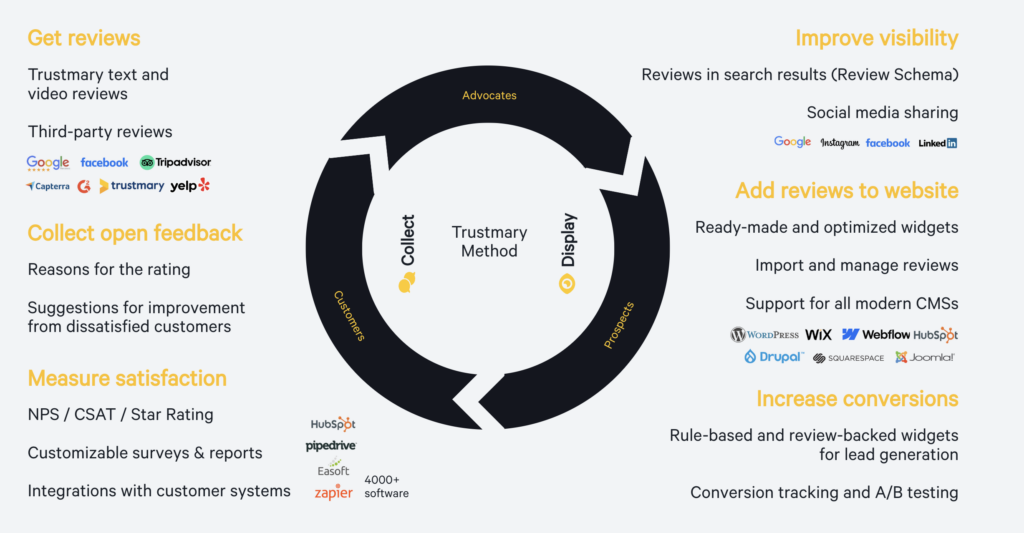Customer Effort Score: Why It Matters and How to Measure It


When it comes to customer experience and customer satisfaction, the Customer Effort Score (CES) stands out as a vital customer experience metric.
Understanding and optimizing CES can lead to higher customer satisfaction, loyalty, and retention. According to research, resolving issues quickly will impact future purchase behavior during the whole customer journey.
Let's face it: A high effort service interaction can be a dealbreaker to any customer.
Next, I'll walk you through why the Customer Effort score is important and how you can effectively measure it.
I'll also tell you how we at Trustmary use customer effort score surveys ourselves to ensure customers are happy!
What is Customer Effort Score (CES)?
Customer Effort Score measures how easy it is for customers to interact with your business and resolve their issues.
Unlike other customer experience metrics like Net Promoter Score (NPS) or Customer Satisfaction (CSAT), CES focuses specifically on the ease of the customer experience.
It uses the Likert scale (from 1-5 or from 1-7) aka the numbered scale poll to get a numeric value for overall satisfaction to a certain event.
Companies should always aim to provide a low effort experience for their customers. The less customer frustration there is, the better.
In less jargon: Make buying and interacting with you as easy as humanly possible.
You don't need a detailed customer experience strategy for this. Just go over your customer journey step by step to figure out which parts might be confusing. Customer effort score surveys should be automated at those key customer touchpoints to measure customer satisfaction.
Based on the answers, either keep your existing processes or improve them based on the feedback.
Why CES Matters
Predicts Customer Loyalty
Studies show that the easier it is for customers to get their issues resolved, the more likely they are to stay loyal to the brand.
In fact, research suggests that when you minimize customer effort to a minimum, you start to increase customer loyalty in the long run.
Reduces Customer Churn
High-effort interactions are a significant predictor of customer churn.
This should be a no-brainer.
Customers who find it hard to get help or solve their problems are more likely to switch to competitors, because it's difficult to get the job done with the service you provide.
In a nutshell: When customer frustration is high, customer loyalty is low, which leads to a higher customer churn rate.
Enhances Customer Satisfaction
CES directly correlates with overall customer satisfaction. When customers find it easy to interact with your brand, their satisfaction levels naturally increase.
How to Measure CES
Designing Your CES Survey
- Keep it Simple: The CES survey typically asks a single question: "How easy was it to resolve your issue today?" Responses are usually recorded on a 5-point or 7-point Likert scale, ranging from "Very Easy" to "Very Difficult."
- Timing is Key: Send the CES survey immediately after a customer interaction, whether it’s a customer service call, a product purchase, or a self-service action on your website. This timing ensures you capture the customer’s immediate reaction and accurate feedback.
- Optimize for Mobile: Ensure your surveys are mobile-friendly since many customer interactions happen on mobile devices. This accessibility can improve response rates and the accuracy of your data.
Analyzing CES Data
- Calculate the Average Score: Sum all the effort scores and divide by the number of responses. A lower average score indicates lower customer effort and a better customer experience. This number is a great baseline for your customer experience design plan.
- Identify Pain Points: Look at responses to find common areas where customers report high effort. These insights help pinpoint specific processes or interactions that need improvement.
- Act on Feedback: Use the data to make informed decisions. Include all your CX metrics to make even more informed decisions. If a particular touchpoint consistently receives high effort scores, investigate and address the underlying issues.
Tips for Improving Your CES
Most businesses wonder how to handle difficult customers, but the first problem is identifying who are unhappy.
CES is a great starting point to start measuring ASAP.
If you've already figured out who are unhappy, and why that is, here's a checklist for what to look at next.
- Streamline Processes: Simplify processes wherever possible. Reduce steps, eliminate unnecessary hurdles, and ensure all customer-facing processes are intuitive.
- Enhance Self-Service Options: Provide comprehensive self-service tools like FAQs, knowledge bases, and chatbots. These tools empower customers to resolve issues quickly without needing to contact support.
- Train Customer Service Teams: Ensure your support staff is well-trained and equipped to handle customer inquiries efficiently. A knowledgeable and responsive team can significantly reduce the effort required by customers.
- Use Automation Wisely: Implement automated systems to handle routine inquiries and follow-ups. Automated surveys, for example, can be sent immediately after a customer interaction to gather timely feedback.
How Trustmary Uses CES Surveys to Enhance Customer Experience
I've found these to be helpful in my work as a Customer Success Manager, and our management team, as well as the board of directors, follow these and other customer satisfaction metrics on a quarterly level.
If you're looking for a tool to automate the collection of customer feedback and reviews, sign up for a free trial!
CES Surveys at the End of Each Chat Discussion
At Trustmary, we prioritize making every customer interaction as seamless as possible. Our goal is to respond to each live chat as fast as possible to provide help when it is needed. This has a direct impact on how we have been able to build customer loyalty
To ensure we maintain high standards, we implement Customer Effort Score (CES) surveys at the end of each chat discussion.
These surveys help us gauge how easy it was for customers to get the help they needed. By asking customers to rate their experience immediately after a chat, we capture accurate, real-time feedback that helps us understand their immediate perceptions.

CES Surveys After Kick-Off Meetings
We also use CES surveys following our kick-off meetings with new clients.
This critical feedback point sets the tone for our future relationship, so understanding how easy and comfortable the process was for our clients is essential.
The feedback from these surveys allows us to refine our onboarding process continually, ensuring that each new client has a positive and effortless start with Trustmary.
Automatic Feedback Integration with Slack
To ensure transparency and a quick response to feedback, all CES survey results are automatically sent to our team’s Slack channels through integration. This setup allows everyone on the team to see customer feedback as it comes in.
This applies to customer-facing teams, but includes software developers as well.
When a customer provides high scores or positive comments, the team is notified immediately, fostering a culture of recognition and praising.
However, sometimes there are negative reviews, which are important to share internally and to take action on right away. Identifying friction points and iterating our processes are key to making sure we turn unhappy customers into happy users.
Providing Support for Positive Feedback
Positive feedback is not only a metric for success but also an opportunity to reinforce good practices. When a team member receives commendable feedback, we ensure they get the recognition they deserve.
This support helps maintain high morale and motivates our team to keep delivering top-notch service. Acknowledging and rewarding good performance is key to maintaining a customer-centric culture and ensuring ongoing excellence in customer service.
By leveraging CES surveys at key customer interaction points and integrating feedback into our daily workflow, Trustmary is committed to providing an outstanding and effortless experience for all our customers.
This continuous loop of feedback and improvement helps us stay aligned with our customers' needs and expectations.
You can also use NPS to measure customer service performance to see how it affects overall customer loyalty.
This is our Trustmary Method in a nutshell:

Create CES Strategy
Customer Effort Score is a powerful metric that can provide deep insights into your customer experience. There are also other CX metrics that you can focus on, but this one is great for ensuring business growth by identifying areas that need immediate action.
By focusing on making interactions easier, you can boost customer satisfaction, loyalty, and overall business success.
Start measuring CES today and use the insights to create a smoother, more enjoyable experience for your customers.
Try the easiest survey tool on the market to measure CES today!
FAQs on CES
What is a good Customer Effort Score?
A higher score indicates less effort and a better experience. Aim for an average score towards the higher end of your scale.
Get a benchmark for your business, and continue measuring CES to see a trend.
How does CES differ from NPS and CSAT?
While the Net Promoter Score NPS measures customer loyalty and the likelihood of recommending a brand, and CSAT measures immediate satisfaction, CES specifically measures the ease of customer interactions.
CES focuses on the more minor aspects of your customer journey while NPS and CSAT focus on the bigger picture. It doesn't make CES any less important, quite the opposite.
It's the total sum of all customer support interactions, support tickets, all the way to operating on your website or using your product.
When should I send a CES survey?
Send the CES survey immediately after a significant customer interaction, such as a purchase, a customer service call, or the use of a self-service tool. Automated customer feedback processes ensure your timing is just right every single time. Even the timing plays a huge role in collecting accurate CES data.
Can CES be used for all types of businesses?
Yes, CES is versatile and can be applied to any industry where customer interactions are crucial, from retail to SaaS to healthcare.
How can I improve a high Customer Effort Score?
Identify the high-effort touchpoints from your CES data and focus on streamlining those processes, enhancing self-service options, and training your customer support team.
Why is CES important for customer retention?
Customers are more likely to stay loyal and repurchase from brands where they have low-effort interactions, making CES a strong predictor of customer loyalty.